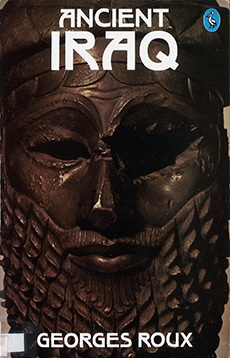Contents
Foreword To The Second Edition / 12
Introduction To The First Edition / 13
I. The Geographical Setting / 19
The Twin Rivers / 22
Regional Variations / 26
Trade Routes / 29
2. In Search of The Past / 34
The Buried Cities of Iraq / 35
Dating the Past / 39
Archaeological Research in Iraq / 44
3. From Cave to Farm / 49
The Pcdaeolithic of Iraq / 52
Mesolithic and Neolithic / 55
4. From Village to City / 61
The Hassuna Period / 62
The Samarra Period / 65
The Halaf Period / 66
The Ubaid Period / 69
5. Birth of a Civilization / 75
The Uruk Period / TJ
The Jemdat Nasr Period / 82
The Sumerian Problem / 85
6. The Gods of Sumer / 90
The Sumerian Pantheon / 91
Tales of Creation / 96
Life, Death and Destiny / 101
7. An Age of Heroes / 106
From ‘Adam’ to the Deluge / 106
The Great Flood / 110
Dynasties of Supermen / 114
The Story of Gilgamesh / 118
8. The Early Dynastic Period / 122
The Sumerian City-States / 124
Early Sumerian Rulers / 130
Outline of History / 134
9. Semitic Interlude / 14O
The Semites / 141
Sargon of Akkad / 145
The Akkadian Empire / 148
10. Sumerian Renaissance / 154
Ur-Nammu and Gudea / 155
Shulgi, Amar-Sin and the Sumerian Empire / 161
The Fall of Ur / 165
II. The Amorites / 169
Isin, Larsa and Babylon / 171
Eshnunna, Assur and Mari / 175
Shamshi-Adad I and his Sons / 179
12. HAMMURABI / 184
The Statesman / 184
The Lawgiver / 189
13. In The Days of Hammurabi / 195
The God in his Temple / 196
The King in his Palace / 200
The Citizen in his House / 204
14. New Peoples / 208
The Indo-Europeans / 209
Asia Minor and the Hittites / 213
Hurrians and Mitannians / 216
Syria and Egypt / 218
15- The Kassites / 223
Hammurabi's Successors / 224
Iraq under Kassite Rule / 227
16. Kassites, Assyrians And The Oriental Powers / 233
Egypt versus Mitanni / 233
The Time of Suppiluliumas / 236
Assur and Susa versus Babylon / 240
17- The Time of Confusion / 246
Israelites and Phoenicians / 248
The Neo-Hittites / 251
The Aramaeans / 253
The Dark Age of Mesopotamia / 257
18. The Rise of Assyria / 262
Genesis of an Empire / 263
Ashumasirpal 267
Shalmaneser III / 273
19. The Assyrian Empire / 278
Assyrian Eclipse / 279
Tiglathpileser III / 282
Sargon II / 287
20. The House Of Sargon / 293
Sennacherib / 294
Esarhaddon / 299
Ashurbanipal / 304
21. The Glory of Assyria / 312
The Assyrian State / 313
The Assyrian Army / 320
Assyrian Arts 323
22. The Scribes of Nineveh / 328
Mesopotamian Science / 330
Mathematics and Astronomy / 334
Medicine / 338
23. The Chaldaean Kings / 343
The Fall of Nineveh / 343
Nebuchadrezzar / 348
The Fall of Babylon / 352
24. The Splendour of Babylon / 359
Babylon, the Great City / 360
The New Year Festival / 365
Economic Life 369
25. Death of a Civilization / 374
The Achaemenian Period / 375
The Hellenistic Period / 381
The Parthian Period / 387
Epilogue / 391
List of Abbreviations / 396
Bibliography And Notes / 399
Chronological Tables / 457
Maps / 470
Index Of Names / 481
Index Of Subjects / 495
Illustrations
Proto-historic buildings and objects (Drawing by the author)
Harp from the Royal Cemetery of Ur (Courtesy British Museum)
Gold helmet of Meskalamdug, from the Royal Cemetery of Ur (Drawing by the author)
Gold dagger from the Royal Cemetery of Ur (Courtesy British Museion)
Fragment of the Stele of the Vultures, from Telloh (Courtesy Louvre Museum)
Bronze head of Sargon (?), from Nineveh (Courtesy Iraq Museum)
Statue of Gudea, ensi of Lagash, from Telloh (Courtesy Louvre Museum)
The ziqqurat of Ur (Courtesy Robert Harding Associates, London)
Central stairs of the ziqqurat of Ur (Courtesy Robert Harding Associates; London)
Statue of Ebih-Il, from Mari (Courtesy Louvre Museum)
Votive dog, from Telloh (Courtesy Louvre Museum)
Head of a god, from Jabbul, Syria (Courtesy Louvre Museum)
A private house at Ur (Drawing by the author)
The Temple of Ishtar-Kititum at Ishchali (Drawing by the author after a reconstruction by Harold D. Hill)
Relief from Tell Halaf (Courtesy Prof. W. Casket, Cologne)
Assyrian statue at Nimrud (Photograph by the author)
Specimen of Assyrian writing on stone, from Nimrud (Courtesy Iraq Petroleum Company)
Stele of Esarhaddon, from Zenjirli {Courtesy Vorderasiatische Museum, Berlin)
Assyrian scene of war. Relief from Nineveh (Courtesy Louvre Museum)
Maps
Mesopotamia: Geography Prehistory Third Millennium B.C.
Sumer and Akkad
Assyria
The Assyrian Empire
The Near East in the Second Millennium B.C. | 